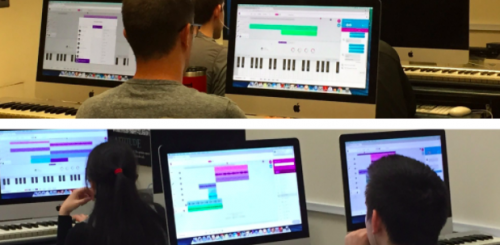
NYC Music Teachers Develop Virtual Projects
October 21, 2020As school openings and reopenings continue to take different forms across the country, reflecting on how different schools have managed successful music programs throughout the pandemic gives us insight into strategies that can work in any learning environment. Many educators, from the classroom level, up to district-wide implementations, have leveraged Soundtrap’s online studio as a flexible option to support seamless learning, whether remotely or in the school building.
New York City is just one such place where Soundtrap is facilitating creative music education. In this post, music teachers from the NYCDOE offer reflections on how they’ve used Soundtrap to continue music learning projects with students over the spring and summer. Their ideas can be useful for educators anywhere who are looking for new things to try.
John Curcio
High School Music Teacher
I have been using Soundtrap to engage kids in both songwriting and piano playing. It has been successful in that it is easy to see real-time editing and performing for the teacher. I have also selected a cappella tracks for students to collaborate and add their own twists and musical elements to the songs they enjoy.
The greatest difficulty of distance learning is revamping an engaging and integrated curriculum for all learners of different cognitive learning levels. Soundtrap has helped me give musically enriching exercises to students at a wide array of levels in the general music environment.
Aaron Bazzell
High School Music Teacher
I used Soundtrap to provide my students with music-making opportunities outside of the traditional classroom. As a high school teacher, my course load consists of two general music classes for freshmen along with separate sophomore, junior and senior band classes.
Unfortunately, many of my students do not possess their own instruments and cannot practice at home. Because of Soundtrap’s generous decision to provide free licenses to educators, I was able to create a film scoring unit for my general music classes and a music production unit for my band classes.
Many students utilize their music classes as their means for expression. It’s important that they continue to have this outlet in these trying times that we’re living in. Thanks to Soundtrap, music educators worldwide have a resource that allows us to continue fulfilling this need.
Kelly Cuevas
Middle School Music Teacher
We used Soundtrap at Wagner Middle School to help students become familiar with some essential functions of a Digital Audio Workstation (DAW). Our 8th grade students, in particular, were using it to create two digital projects to allow them to continue to collaborate as musicians while apart.
One of the projects entailed recording an excerpt from one of the pieces they played at their first concert and then uploading it to a shared project to align and edit. I took that same excerpt from the audio recording from their 6th grade concert and created a digital project that shows their growth as musicians over the years. The project came about from an idea a student had when back in the physical school building and planning to do a live Spring Concert.
In addition to our 8th grade digital projects, some of our students have enjoyed exploring and taking on their own creative projects just for fun, which has been great to see! One of my jazz band students recorded herself, combined it with loops, and created her own backing track to practice improvising over. Another student recorded herself playing individual notes on her clarinet and then used the editing functions to build chords and re-create her version of “Can’t Help Falling in Love:”
Dr. Gregor Winkel
High School Music Teacher
Using Soundtrap, students are asked after pre-exercise to record the four parts of a J.S. Bach Chorale correctly into four different tracks in sync with themselves. After this exercise, the students will hopefully be ready for a larger project.
Additionally, students are recording the band parts of a concert band composition. Using Soundtrap collaboration, instrument section leaders are recording and synchronizing their parts with their section members. Student monitors are eventually synchronizing and combining the elements from different sections. It requires well thought out and thorough logistics that the students follow. So far, I have done this with bands of about one hundred students.
 EDU Portal
EDU Portal

